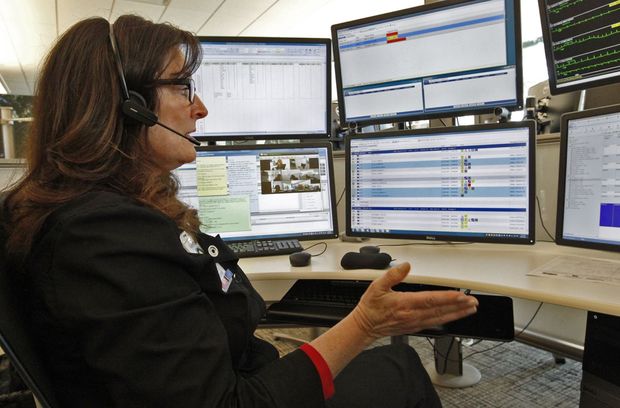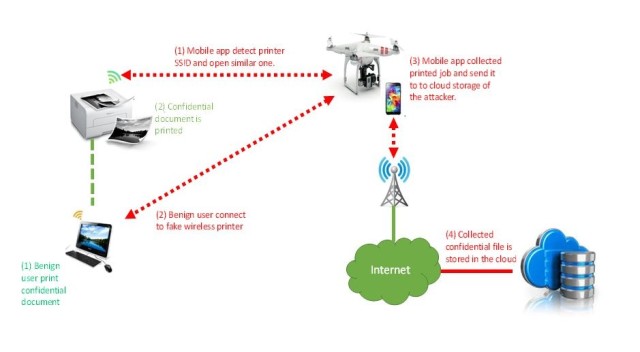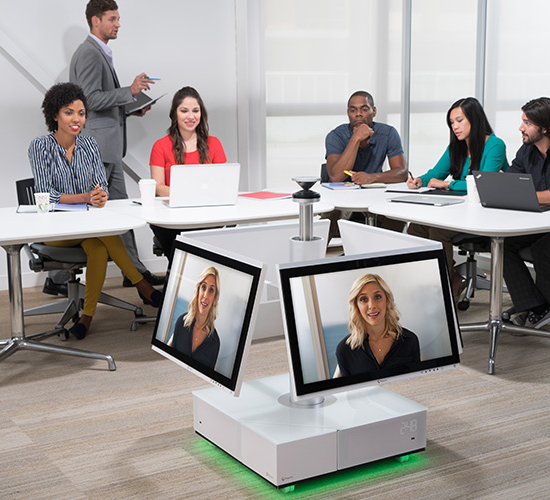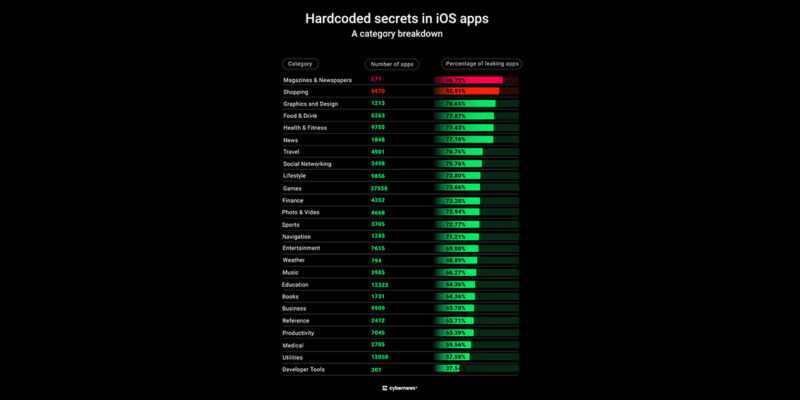Convergent TechWeek 10/9
Telemedicine and the World’s First Virtual Care Center
At first glance, it looks like the inside of any office with cubicles and computer monitors – with one exception – many of the employees are dressed in hospital scrubs. These workers are actually nurses taking care of patients, though there are no hospital beds, no waiting rooms and no patients. It’s not even inside a hospital or a clinic.
Chesterfield-based Mercy Health’s latest $54 million facility was built to deliver services remotely – through telemedicine. Mercy’s main business line is providing care at its 33 hospitals spread across Missouri, Oklahoma, Kansas and Arkansas. The idea is to improve access to care by allowing patients to visit with clinicians when and where they want. So far, the breadth of what Mercy is doing is contracting with other businesses, mainly rural hospitals, to be a second set of eyes and ears in the intensive care units.
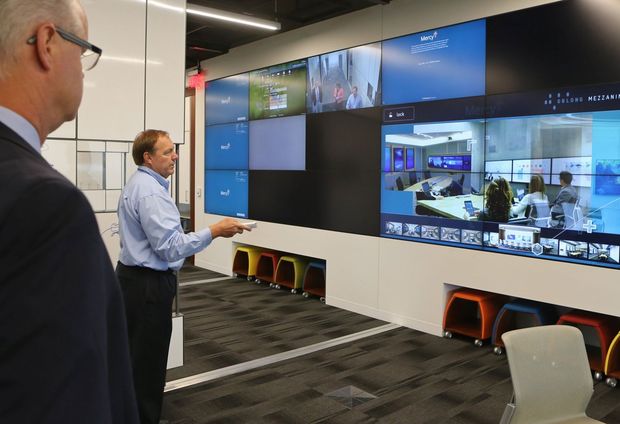 Dr. Randy Moore, (left) Mercy Virtual President, and Dr. Thomas Hale, Executive Medical Director of Mercy Virtual, demonstrate the futuristic video screens where multiple groups from remote locations can get together for conferencing.
Dr. Randy Moore, (left) Mercy Virtual President, and Dr. Thomas Hale, Executive Medical Director of Mercy Virtual, demonstrate the futuristic video screens where multiple groups from remote locations can get together for conferencing.
One of the registered nurses employed at the facility, Cara Edmunds’ eyes move back and forth between the six computer screens at her desk. On one screen she uses software to turn on a camera stationed above a patient’s bed in Arkansas — 800 miles away from her station in Chesterfield. The patients can also see and talk with her. After getting used to this new type of interaction, Edmunds found she was getting to know her patients just like before.
Edmunds, though, never imagined she would be working in a virtual care center such as this. “Who would have thought that, right?”
Mercy’s telehealth services are powered by Vidyo.
St. Louis Post Dispatch: Mercy debuts new $54 million virtual care center
World’s Largest Radio Telescope Being Constructed in China
China is assembling what has been hailed as the world’s largest radio telescope with a dish the size of 30 football fields, state media has reported. Its unique design will allow scientists to gather radio signals from tens of billions of light years away. The construction of the highly sensitive telescope began in March 2011 and is due to be completed next year.
Drone aerial view
With a perimeter of about 1.6km, it will take up to 40 minutes to walk around the single-aperture spherical telescope, which is called “FAST”. It will be constructed deep in the mountains of the southwestern Guizhou Province, built on a naturally formed bowl-shaped valley, Xinhua reported in July.
China may complete construction of the world's largest single-aperture radio telescope in 2016 http://t.co/Rfbiy0Zj5V pic.twitter.com/X18eY4qhdW
— People's Daily,China (@PDChina) July 24, 2015
Tech Insider: China is building the world’s largest radio telescope to detect signs of life billions of light years away
RT: ‘Fast’ & vast: China building world’s largest 500-meter radio telescope (from July)
Smartphone-Equipped Drone Can Break Into a WiFi Network
As if enterprise organizations weren’t already in a heightened state of awareness concerning the security of their wireless networks…
A team of security researchers from Singapore has reportedly devised a method of intercepting wireless printer transmissions using smartphones attached to drones. In other words, they can gain access to your network by using a smartphone-equipped drone to hack your printer. The technology was developed by researchers from iTrust, a cybersecurity research center at the Singapore University of Technology and Design.
The iTrust system, designed as an inexpensive way for companies to test the security of their Wi-Fi networks, uses drones to transport a smartphone to an area where a wireless network with wireless printers is located. Unlike notebook-based detection systems that require building access, drones can fly outside a skyscraper and find vulnerable networks with minimal interference.
For threat actors though, wireless printers represent a weak link in a company’s wireless network. Wireless printers are typically supplied with the Wi-Fi connection open by default, and many companies forget to close this hole when they add the device to their Wi-Fi networks. This open connection potentially provides an access point for outsiders to connect to a network and steal a company’s sensitive data.
To mitigate this vulnerability, the researchers developed a second app they called “Cybersecurity Patrol”.
Digital Trends: This smartphone-equipped drone breaks into Wi-Fi networks through unsecure printers
A Firehose That Moves Data, A Snowball for Storage – AWS re:Invent 2015
This week at AWS re:invent, Amazon introduced a new service called Kinesis Firehose to move data streaming from sensors and other locations directly to the cloud.
Andy Jassy, SVP at Amazon Web Services (AWS), claims that with a single API call to Firehose, customers can now put data into Amazon Redshift or S3 and immediately begin working with the data. This gives AWS a couple of advantages as it allows the company to expand its big data coverage to the Internet of Things (which has the potential to produce a tremendous amount of data on a daily basis) and it expands the amount of data being stored on the system exponentially.
Amazon also surprised developers with the launch of Snowball, a new physical appliance that will allow AWS users to ship huge amounts of data for import into AWS by shipping the device back and forth between their offices and the AWS data centers.
The appliance is a bit larger than an “old-school” desktop case and it can hold up to 50 terabytes of data. It has a Kindle on the side, which functions as an automatic shipping label.
Full coverage of AWS re:Invent 2015 can be found here.
TechCrunch: AWS Introduces Kinesis Firehose To Move Sensor Data To Cloud
TechCrunch: Amazon Launches Snowball, A Rugged Storage Appliance For Importing Data To AWS By FedEx
Polycom Announces Innovative Solutions to Transform Collaboration Experiences
It was a very big day for Polycom on Oct. 7th as they unveiled innovative collaboration solutions at an exclusive customer event in New York, focused on advancing the workplace of the future globally – led by Peter Leav, President and Chief Executive Officer, Michael Frendo, Executive VP of Worldwide Engineering and Ashan Willy, Sr. VP, Product Management & Worldwide Systems Engineering.
Polycom CEO Peter Leav talks vision and strategy. #FutureofWork pic.twitter.com/2WklbZg8qk
— Polycom (@Polycom) October 7, 2015
“As we celebrate our 25th year of innovation and leadership, we are announcing breakthrough collaboration experiences that uniquely place people at the heart of collaboration enabling them to work better, smarter and more efficiently. said Peter Leav. We are delivering the workplace of the future today.”
Polycom introduced several innovative new products:
- Polycom® RealPresence Trio™ – a smart hub for all meeting spaces
- Polycom® RealPresence Centro™ – a collaboration experience at the center of human collaboration
- Polycom® RealPresence Debut™ – brings enterprise grade video collaboration to the huddle room with a focus on simplicity and affordability
- Polycom® RealPresence® Medialign™ – a turnkey Polycom® RealPresence® Group Series solution for multiple work environments
- Polycom® Concierge – the first enterprise software that instantly connects your device to solutions across Polycom’s collaboration portfolio for ease of conference control
- Polycom® VVX® business media phones – the first phones to support and interoperate with the forthcoming cloud voice service offering as part of Microsoft Office 365.
The one product that seemed to get the most attention was RealPresence Centro, which according to the company was “built with instinctual human behavior in mind” as people feel more comfortable communicating and collaborating in the round. Polycom’s patented 360-degree voice and video technology automatically tracks the speaker, while also showing the entire meeting space on the same screen.
One of my Tweets as I viewed the webcast on Wednesday:
@Polycom Michael Frendo and @awilly Unveiling the #Workplace of the Future with new solutions – asking "What if?" #futureofwork
— Corey Moss (@Cbmoss) October 7, 2015
For further details on these product releases as well as availability see the Polycom press release.
Building the World’s First Artificial Intelligence to Match a Human’s
I was tasked to find a story involving Elon Musk and artificial intelligence and these days they’re not hard to come by. However while Musk and others (including Stephen Hawking and Steve Wozniak) have continued to spell futuristic gloom and doom (more dangerous than nukes) over the prospects of artificial intelligence (AI) and robots replacing humans in work environments, here is a situation where he is an investor in an artificial intelligence lab called Vicarious, a company that is also funded by Facebook’s Mark Zuckerberg, Amazon’s Jeff Bezos and actor Ashton Kutcher which wants to do something completely radical — build the world’s first human-level artificial intelligence (AI).
Founded in 2010 by computer scientist Scott Phoenix and neuroscientist Dileep George, Vicarious and their funders are in it for the long term as their general purpose AI probably won’t be ready for several years, and they don’t expect to make much money on top of the $70 million they’ve raised until then.
A computer that has human-level intelligence wouldn’t just be a breakthrough in AI, it would answer one of the most fundamental questions in science – how do you build an intelligent machine – by building an AI that emulates how the brain works, specifically the neocortex, the area of that brain that’s responsible for perception and information processing, and reportedly they’re making incremental progress.
“Vicarious is building a single, unified system that will eventually be generally intelligent like a human,” Phoenix wrote in a World Economic Forum Q and A.
Most researchers think building a human-level AI will likely take longer than one decade. Philosopher Nick Bostrom surveyed 550 AI researchers to gauge when they thought that human-level AI would be possible. The researchers responded that there is a 50% chance that it will be possible between 2040 and 2050, and a 90% chance that it will be built by 2075.
And what of Musk’s investment in an artificial intelligence lab? As stated by Eric Mack, Forbes/Tech contributor in a January 2015 article “Why Elon Musk Spent $10 Million To Keep Artificial Intelligence Friendly”:
For all his bluster about the dangers of AI, which is supported by others like Hawking and Nick Bostrom in his recent tome on the topic, “Superintelligence,” I’d wager Musk has decided to be vocal on the issue and to make this “donation” as a pre-emptive strike against negative public opinion, a potential obstacle for AI on its journey towards maturity and profitability. In other words, for Musk, it’s about protecting an investment as much as it is about protecting humanity from mean-spirited machines.
To (of course) be continued…
Tech Insider: The mysterious artificial intelligence company Elon Musk invested in is developing game-changing smart computers (pardon the buzz word in the title).
ZME Science: Elon Musk and Mark Zuckerberg invested in the ultimate AI



